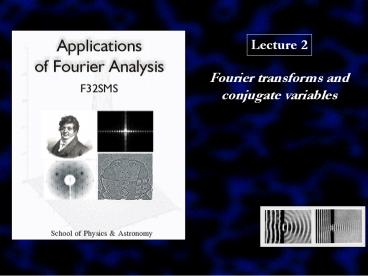Fourier transforms and - PowerPoint PPT Presentation
Title: Fourier transforms and
1
Lecture 2
Fourier transforms and conjugate variables
2
Recap.
Fourier analysis involves decomposing a
waveform or function into its component
sinusoids. spans practically every area in
physics. converts from the time to frequency
domain (or vice versa), or from real space to
reciprocal space.
NB There is a typo. on p. 9 of the lecture notes
handout. In the last paragraph on that page,
wt2p should be wtp.
3
Fourier Analysis Gibbs phenomenon
?
At what points in the waveform is the Fourier
series representation of the function poorest?
- At discontinuties.
Note that the Fourier series representation
overshoots by a substantial amount.
NO!
4
Fourier Analysis Gibbs phenomenon
The inclusion of more terms does nothing to
remove the overshoot it simply moves it closer
to the point of discontinuity.
Therefore, we need to be careful when applying
Fourier analysis to consider the behaviour of a
function near a discontinuity
Gibbs phenomenon, however, is not just of
mathematical interest. The behaviour of electrons
near a sharp step in potential (e.g. at a
surface) is fundamentally governed by Gibbs
phenomenon.
http//www.almaden.ibm.com/vis/stm/images/stm6.jpg
5
Outline of Lecture 2
- From Fourier series to Fourier transforms
- Pulses and top hats
- Magnitude and phase
- Delta functions, conjugate variables, and
uncertainty - Resonance
6
Dirichlet conditions
- There are a number of conditions (the Dirichlet
conditions) which a function must fulfil in order
to be expanded as a Fourier series - must be periodic
- must be single-valued
- must be continuous or have a finite number of
finite discontinuities - integral over one period must be finite
- must have a finite number of extrema
Luckily, the vast majority of functions of
interest in physics fulfil these conditions!
7
Fourier Analysis Spectra
?
Sketch the frequency spectrum (i.e. Fourier
coefficients) for the pure sine wave shown below.
8
Fourier Analysis Spectra
NB Note presence of 0 Hz (i.e. DC term) the
value of A0 is given by
Bn
4
Frequency (Hz)
0
1
2
3
9
Complex Fourier series
As discussed (and derived) in the Elements of
Mathematical Physics module
Practice/revision problems related to both the
trigonometric and the complex forms of the
Fourier series feature in this weeks Problems
Class.
10
From Fourier series to Fourier transforms
?
For what type of function is it appropriate to
use a Fourier transform as opposed to a Fourier
series analysis?
11
From Fourier series to Fourier transforms
f(t)
t
Discrete frequency components for periodic
waveform
12
Beyond time and frequency
Fourier analysis is not restricted to time ?
frequency transformations. Consider a periodic
(1D) lattice e.g. a wire of atoms with
lattice constant a.
a
If a is the lattice period, then the spatial
frequency associated with this lattice is 2p/a.
13
Beyond time and frequency
Just as we can transform from time to frequency,
we can transform from space to spatial frequency
(inverse space) s ? s-1, m ? m-1
Remarkably, a diffraction pattern is the Fourier
transform of the real space lattice. (Holds true
for any scattering experiment photons, X-rays,
electrons....)
14
Crystallography and Fourier transforms
Electron diffraction pattern reciprocal space
lattice (Fourier transform of real space lattice)
STM image of Si surface showing real space lattice
15
Time-limited functions and bandwidth
16
Time-limited functions and bandwidth
17
The ultimate time-limited functionDirac
d-function
?
So, in the limit of the pulse width ? 0, what
happens to the pulses Fourier transform?
Fourier transform becomes broader and broader as
pulse width narrows. In the limit of an
infinitesimally narrow pulse, the Fourier
transform is a straight line an infinitely wide
band of frequencies.
18
Magnitude, phase, and power spectra
Fourier transform is generally a complex
quantity. - Plot real, imaginary
parts - Plot magnitude -
Plot phase - Plot power
spectrumF(w)
2
Take two quantities, z e-ikx and y sin w
19
Magnitude, phase, and power spectra
A complex number, z, can be written in the form z
reif where r is the magnitude (or modulus) of z
and f is the phase angle.
20
Magnitude, phase, and power spectra
?
Calculate the Fourier transform of d(t-t0).
21
Why power spectrum?
The power content of a periodic function f(t)
(period T) is
If f(t) is a voltage or current waveform, then
the equation above represents the average power
delivered to a 1 W resistor.
22
Why power spectrum?
For aperiodic signals, Parsevals theorem is
written in terms of total energy of waveform
Total power or energy in waveform depends on
square of magnitudes of Fourier coefficients or
on square of magnitude of F(w). (Phases not
important).
23
Fourier Transforms and the Uncertainty Principle
Note the reciprocal nature of the
characteristics of the function and those of its
Fourier transform.
Narrow in time ? wide in frequency Dt ? ? Df ?
24
Fourier Transforms and Resonance
?
Write down a mathematical expression for the
response of the damped harmonic oscillator shown
in the graph above.
25
Localisation and wavepackets
?
There is something fundamentally wrong with using
a plane wave description (eg. )
to describe a quantum mechanical particle. What
is it?
26
Wavepackets
To localise the particle in space we need a
spread of momentum (or wavevector) values.































